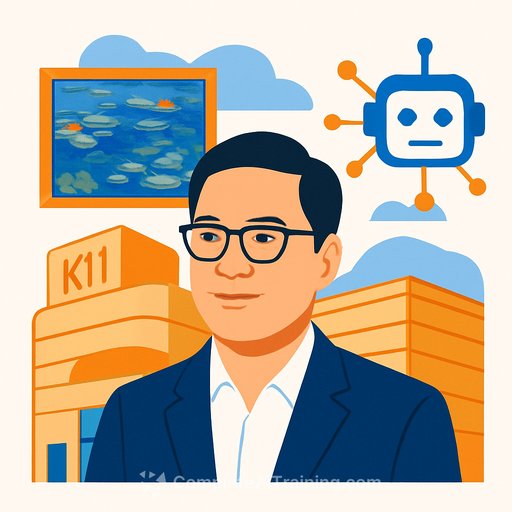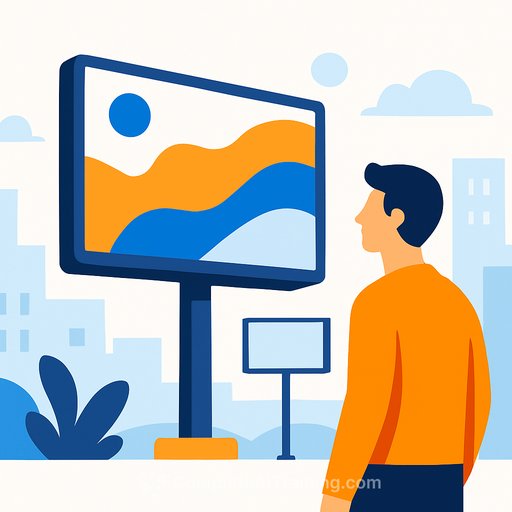Adrian Cheng's Playbook for Creatives: Where Art, Commerce and Code Meet
For two decades, Adrian Cheng has turned Hong Kong into a living case study for how art can move beyond white walls without losing its integrity. He doesn't separate art, design, retail or tech-he builds systems where they amplify each other.
His work spans K11's cultural-retail ecosystem, museum partnerships across continents, and salons that pair artists with technologists. If you're a creative thinking about scale without compromise, his approach is worth studying.
From Mall to Museum-Grade: The K11 Model
In 2008, Cheng founded K11 to merge museum-standard art with high-end retail across Hong Kong and mainland China. The flagship project, Victoria Dockside-home to K11 MUSEA-turned the harbourfront into a cultural district where audiences come for shopping and stay for art.
In 2014, K11 Art Mall in Shanghai showed 40 works by Claude Monet, including Water Lilies and Wisteria, with loans from the Musée Marmottan Monet. The spark came from Cheng's love for the immersive Water Lilies at the Musée de l'Orangerie in Paris-proof that inspiration scales when you build the right container.
Cross-Border Culture in Action
The Monet show lined up with the 50th anniversary of Sino-French cultural relations, and that spirit carries through Cheng's foundations. Partnerships run deep: Palais de Tokyo, Centre Pompidou, The Met, New Museum, LACMA, Serpentine Galleries and the Royal Academy of Arts, to name a few.
These collaborations aren't vanity plays. They produce residencies, exhibitions and research that move artists-and audiences-forward.
K11 Art Foundation: The Salon Era
Launched in 2010, K11 Art Foundation (KAF) supports emerging Asian artists and curators. So far: 1,600 exhibitions and educational programs with 900+ artists, curators and organisations.
In 2024, KAF launched a salon series during Frieze Seoul, prioritising the meeting point of art and technology. In the last year, there were 10 salons across seven cities, including one during Paris Art Week featuring Vivien Zhang and Alexis Loisel-Montambaux, moderated by John Tain. More are booked into 2026 for Hong Kong Art Week, Art Basel in Basel and Berlin Art Week.
Craft, Technique and Story: KCG's Focus
K11 Craft & Guild Foundation (KCG), founded in 2018, preserves fast-disappearing Chinese craftsmanship through research, education and collaboration. Core areas include Guangcai (Canton enamel), Baibaoqian (stone inlay), Luodian (mother-of-pearl inlay), gilt-decoration, plaster moulding, wooden architecture and Kesi (silk tapestry).
KCG is co-sponsoring a two-year research project with the Centre de recherche du château de Versailles, led by Mathieu Da Vinha, comparing craftsmen under Louis XIV with Chinese counterparts. This year's focus: goldsmithing-Xinjiang styles linked to Silk Road exchange and Beijing Imperial techniques from the Qing Court.
New Platforms: K11 by AC and ALMAD
Cheng recently launched K11 by AC, a cultural retail developer and operator built for a broad audience-from devoted art goers to millennials and Gen Z. He also founded ALMAD Group, spanning culture, entertainment, sports, media, healthcare, commercial management and cultural tourism.
Translation for creatives: build platforms, not projects. The system does the heavy lifting.
Hong Kong's Edge in the Global Art Market
Cheng sees Hong Kong as a long-term hub for international art trade. The government's Mega Arts and Cultural Events Fund (launched in 2023) has approved 17 major projects with over HK$198 million in support.
There's also real infrastructure: institutions like M+, Tai Kwun and the Hong Kong Palace Museum; no import duties, VAT or GST on artworks; and leading auction houses on the ground. The ecosystem makes it easy to participate-and easier to stay.
The Collector's Lens
Cheng's first buy was a student lithograph in his college years-a reminder that collecting starts with curiosity, not status. His latest: a generative digital work by Cheng Ran with applied science artist Sun Bohan, powered by algorithmic code.
One regret: a site-specific painting by Matthew Wong for a public project in Hong Kong that never reached completion after the artist passed away. Public art needs moments like that-works that meet people where they live.
Art x Tech: Code as a Brush
Cheng is energized by genuine machine-human collaboration. When tech becomes as intuitive as paint, disciplines blur and new forms of work appear in real time.
Artists writing code as material-setting parameters and letting systems evolve-introduces surprise, nuance and feeling into digital practice. That's not a gimmick; it's a new craft.
How Collecting Evolves Next
Expect hybrid collections: physical works plus digital editions. Fractional ownership opens access. AR and VR displays help collectors live with work in fresh ways.
Public ledgers bring clarity to provenance and research. That transparency changes how trust is built.
Beyond Gatekeepers: A Hybrid Market
Galleries still matter for curation and care. But discovery now happens across Instagram, X and TikTok, where artists can build communities directly.
The smart move is hybrid: gallery partnerships plus digital channels. That's how under-represented voices gain real traction.
Fine Art Meets Craft
The old split between art, craft and design is shrinking. Technique isn't the endpoint; intention is.
Jewellery, wine and fashion can carry cultural critique and memory with the same weight as a painting. "The art in the craft; the craft in the art" isn't a slogan-it's a working method.
Practical Moves for Creatives
- Create your own "salon": host small, recurring conversations at the intersection of your medium and one other field (code, scent, sound, materials). Consistency beats size.
- Build hybrid distribution: pair a gallery or curator with your own digital channels and community. Treat both as primary.
- Prototype public encounters: think beyond exhibitions-installations in retail, transit, or hospitality spaces meet audiences where they already are.
- Explore generative practice: treat code like clay. Set rules, let systems respond, then edit with taste.
- Document provenance openly: publish process notes, materials and versions. It builds trust and value over time.
- Collaborate across disciplines: invite an engineer, choreographer or scientist into your next project. Cross-pollination widens your toolkit.
- Collect with intention: mix physical and digital works that sharpen your taste and inform your practice.
- Level up your AI skills: use tools to prototype, test and present faster. If you need a starting point, see the latest curated picks here: Complete AI Training.
Why This Matters
Cheng's model shows that culture grows when you build durable platforms, invite collaboration and keep the bar high. If you make work, curate work or collect it, the next phase rewards those who connect art, space and technology with intention.
Start small. Build the ecosystem around your practice. Let the work lead-then make room for more people to meet it.
Your membership also unlocks:






